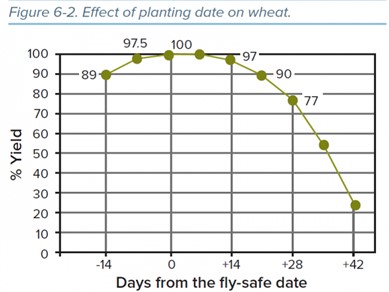By Laura Lindsey and Pierce Paul
Generally, the best time to plant wheat is the 10-day period starting the day after the fly-free-safe date. When wheat is planted more than 10 days after the fly-free-safe date, there is an increased change of reduced fall growth and reduced winter hardiness. The effect of planting date on wheat yield is shown in Figure 6-2 of the Ohio Agronomy Guide, 15th edition.

There is still time to plant wheat. Wheat planted 3 to 4 weeks after the fly-free-safe date can achieve a similar yield as earlier planted wheat if freezing weather does not occur until late November or early December. However, as we enter three to four weeks after the fly-free-safe date, growers should plant at a higher seeding rate than the regularly recommended 1.2 to 1.6 million seeds per acre in 7.5-inch rows. Instead, plant at a rate of 1.6 to 2.0 million seeds per acre. The number of seeds per pound and germination rate are important for determining the correct seeding rate and calibration. There are fewer seeds per pound of large seeds than per pound of small seeds. The number of seeds per pound can be found on the seed bag. Additionally, late planting also means plants will be smaller than normal when entering dormancy and have smaller and shallower root systems than normal, making them more susceptible to heaving next March. The best heaving control is to get the seed placed between 1.0 and 1.5 inches deep when planting and to plant without tillage.
Source : osu.edu